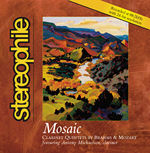| Columns Retired Columns & Blogs |
Editor's Choice: Stereophile's Sampler & Test CD Track 4
[4] Mozart: Clarinet Quintet in A Major, K.581, Larghetto (from Mosaic, STPH015-2)
Performers: Antony Michaelson, Rossi clarinet in A; Adrian Levine, first violin (the "Wilmotte" Stradivarius); Kathy Andrew, second violin; Stephen Tees, viola; Judith Serkin, cello
Recording Venue: Blue Heaven Studios, Salina, Kansas
Recording Date: May 11, 1999
Producers: Adrian Levine & John Atkinson
Assistant Engineer: John Brandt
Microphones: two Neumann M147 1" tube cardioids (ORTF pair); two DPA 4006 ½" omnis with diffuse-field nosecones (spaced pair)
Mike Preamps: two Millennia Media HV-3Bs
A/D Converters: dCS 902D and 904D (both 24-bit) at 88.2kHz
Recorders: Nagra-D (cardioids); Tascam DA-38 with PrismSound MR-2024T bit-splitter (omnis)
88.2kHz/44.1kHz downconversion: dCS 972 Digital/Digital Converter
Mixer: Sonic Solutions Digital Audio Workstation (4 channels)
24-16-bit Noiseshaping: Meridian 518
 Chad Kassem's Blue Heaven Studios was originally a church, and the opportunity to record the Antony Michaelson Quintet in its supportive acoustic while being able to make use of its state-of-the-art facilities was too good to pass up.
Chad Kassem's Blue Heaven Studios was originally a church, and the opportunity to record the Antony Michaelson Quintet in its supportive acoustic while being able to make use of its state-of-the-art facilities was too good to pass up.
The main pickup was a pair of cardioid mikes, this time tubed Neumanns, which have good "reach" due to their slight presence-region boost on-axis. They also paint a well-defined stereo image, but, like all cardioids when used at a distance, they tend not to have enough bass. So I also used spaced omnis. To a purist—as I once was—spaced omnis are anathema because you get almost no true stereo image. However, you do get great low frequencies and a very natural midrange tonality. When I returned home from location, I adjusted the relative timing of the two pairs of tracks to combine the well-defined stereo imaging of the central pair with the full bass and excellent midrange tonality of the spaced omnis.
What you should hear: Mozart's Larghetto is one of the pinnacles of the clarinet repertoire. Although it was originally written for a basset clarinet, which has extra bass extension, the work's contemplative and haunting melody and its bubbling accompanying arpeggios perfectly fall within the smaller instrument's wide compass. The clarinet was to the far right of the stage, the cello in the center, the first violin to the far left, with the viola between the cello and the clarinet and the second violin between the cello and first violin. The three upper strings play con sordini, mutes on their bridges thinning their tone.
At climaxes, the image of the clarinet does splash a little to the other side of the stage. This was due both to some early reflections of its sound from the altarpiece and to the instrument being aimed straight at the opposite mike. The imaging was more precise with the players farther out in the hall, but then they couldn't hear each other well enough, which affected their intonation. I decided to sacrifice some of the image specificity. Nevertheless, you should unambiguously perceive the positions of the instruments most of the time. Listen in particular to the closing passage, where an arpeggio motif is passed around the strings under the clarinet's soaring held notes, starting with the first violin, then the viola, and finally the cello.
- Log in or register to post comments




































